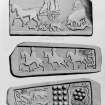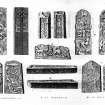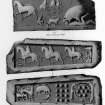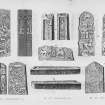Pricing Change
New pricing for orders of material from this site will come into place shortly. Charges for supply of digital images, digitisation on demand, prints and licensing will be altered.
Upcoming Maintenance
Please be advised that this website will undergo scheduled maintenance on the following dates:
Thursday, 9 January: 11:00 AM - 3:00 PM
Thursday, 23 January: 11:00 AM - 3:00 PM
Thursday, 30 January: 11:00 AM - 3:00 PM
During these times, some functionality such as image purchasing may be temporarily unavailable. We apologise for any inconvenience this may cause.
Meigle
Architectural Fragment (Pictish)
Site Name Meigle
Classification Architectural Fragment (Pictish)
Alternative Name(s) Meigle Stones; Meigle No. 10
Canmore ID 30839
Site Number NO24SE 25.10
NGR NO 2872 4459
Datum OSGB36 - NGR
Permalink http://canmore.org.uk/site/30839
- Council Perth And Kinross
- Parish Meigle
- Former Region Tayside
- Former District Perth And Kinross
- Former County Perthshire
NO24SE 25.10 2872 4459.
Meigle No. 10 was a part of a slab of sandstone(?) of nearly
rectangular shape, but fractured along three edges, 3 feet long by 1 foot 6 inches high, sculptured in relief on one face. Front.- A portion of a single panel, containing a figure subject consisting of (on the left) three men in a chariot 1 drawn by a pair of horses abreast of each other; (below the chariot) a kneeling figure with a bow (as on the "D rosten" stone at S Vigeans, Forfarshire), shooting at a beast; (at the right hand upper corner) the hind part of a hound with its tail curved between its leg s; and (at the bottom on the right) a huge beast devouring a man, who lies prostrate on the ground and is thrusting a weapon into the beast's heart; facing it is a hound at bay, behind the archer another hound retreating.
This stone is now lost.
J R Allen and J Anderson 1903
Note (1990)
NO24SE 25.10 2872 4459.
This architectural frieze, which was formerly situated on a mound in the burial-ground (NO33SE 33.01), is now lost. It has, however, been illustrated on several occasions and, although some of the representations may by derived from earlier sources, there is no reason to doubt their interpretation of the decoration. The illustrations show, on the left, a two-wheeled carriage pulled by a pair of horses with a driver holding the reins and two passengers beneath a canopy; below, an archer aimed at a beast. At the right a huge beast bit the head of a prostrate figure, who is apparently thrusting a weapon into his attacker's neck. Behind the archer and above the large beast there are further fragmentary animals - possibly representations of hunting-dogs.
The illustrations in Chalmers and Stuart are different in several ways, the former by Jastrzcbski and the latter by Gibb; Stuart implies there were inaccuracies in the earlier drawing 'apparently from their hasty execution', and thus, although both are shown here, the latter should perhaps be preferred. The spindle-shaped spokes of the carriage are clearly shown, as are details of the biting beast and its victim. The animals are shown with greater precision, including the plaited tails of the horses. With two independent illustrations of this stone, the general arrangement of the figures and the carriage seem to be clear. The 'knot' in the reins is also shown by Pennant's illustrator, Moses Griffith, in 1772.
Information from RCAHMS (JNGR) 1990.
T Pennant 1776; P Chalmers 1848; J Stuart 1856.




















